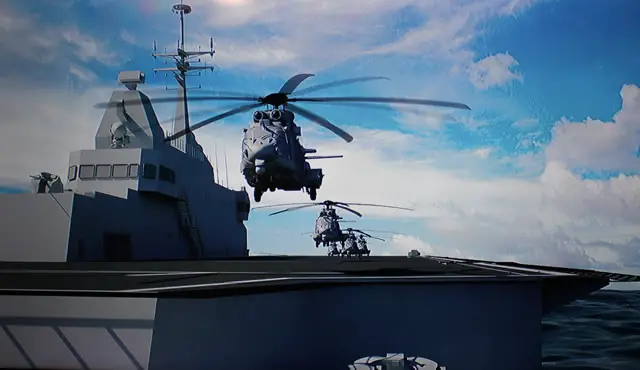Endurance 170 LHD/LHA
Endurance 170 design, a landing helicopter assault (LHA) ship that measures 170m long from ST Marine Singapore, and was first displayed at IMDEX Asia 2017. It is an evolution of the Endurance 160, of which a scale model was on display. Far more capable than the four-ship Endurance 140 LPD class currently operated by the Republic of Singapore Navy (RSN), ST Marine said it had a 'potential customer' for the Endurance 170.
While the shipbuilder would not be drawn on who its client was, the RSN has been talking about it since 2014, of acquiring a larger Joint Multi-Mission Ship. There are five landing spots on the LHA's full-length 4,200m² flight deck, plus a below-deck hangar deck can accommodate ten medium-sized helicopters.
New Endurance 170 design Tan Ching Eng, senior vice president of ST Marine's engineering design center II, said, to save deployment time, helicopter rotor blades can be fully deployed before the aircraft ascends either from the LHA's two elevators. The Endurance 170 has a full load displacement of 19,000t, is 170m in length and 30.8m in width. Its ship crew numbers 140 plus 150 for the aircrew. It can also carry up to 400 troops. Maximum speed is listed as 20kt, its range is 7,000nm and an endurance of 30 days.
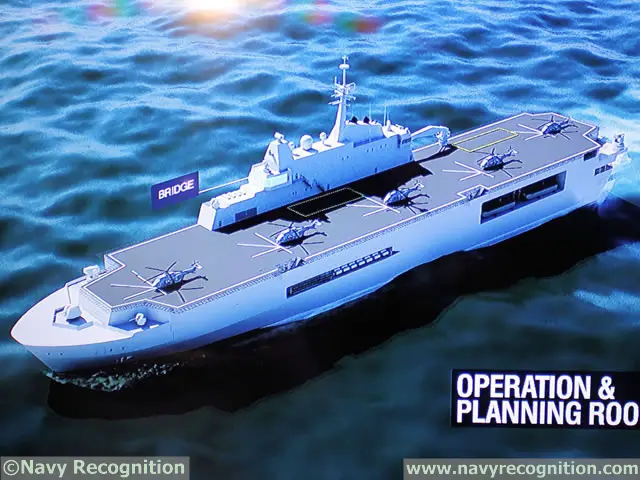
The well deck can accommodate four landing craft plus up to 17 tanks on the vehicle deck. Another deck can fit 16 30t armoured vehicles. A 1,000m² medical facility, with three operating theatres, ten intensive care unit beds and 17 ward beds, is integral to the design.
Weaponry being promulgated, dependent on customer preference, includes a 76mm gun, 30mm remote-control weapon systems, close-in weapon systems, and a vertical-launch missile system.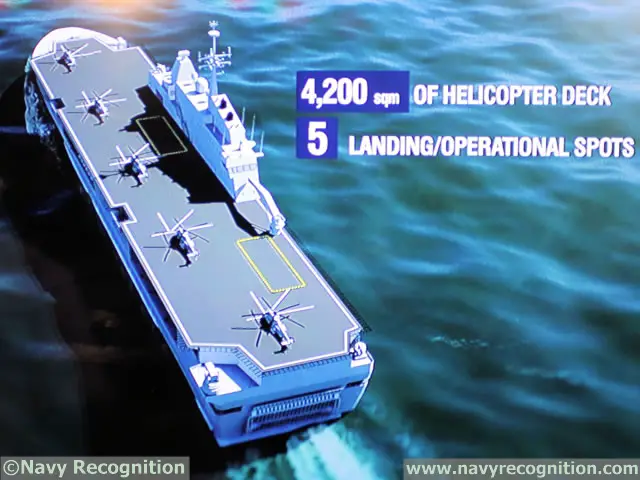
Based on the existing Endurance 160 design, the new vessel was designed as a multipurpose command and support ship for maritime operations. It can act as a command and logistic support vessel for humanitarian assistance and disaster relief and search and rescue operations. The Endurance 170 LHD can also conduct amphibious operations and project power (troops and equipment) via ship to shore connectors or helicopters.
The design features 4,200 square meters of helicopter deck and 5 helicopter spots on the flat deck. The hangar deck measuring 2,050 square meters can accommodate up to 10 medium-size helicopters.
- Options for the NZDF and RNZN 2nd enhanced Sealift vessel
- How much for an enhanced sealift vessel?
- Making tracks to New Zealand
- Defence paper seen as pushing back on China's Pacific influence
- Sense of scale
The Defence Capability Plan 2019 calls for a second enhanced sealift ship, it states "An example of the class of vessel that could be considered under this project is a Landing Platform Dock." the important words here are "example", "could" and "considered". This means that they won't be just looking at LPD's they will also be looking at small LHDs or LHA and the Endurance 170 meets all the requirements of what the DCP - 2019 set out and adds more and while we don't know the price of this vessel, the initial indicative capital cost of "More than $1b." is most likely in its price range. Being built in and by the Singaporian shipyard ST Marine, this vessel would most likely not be that much. "More than $1b", is a heck of a lot money for an LPD, for that much you might as well get the LHD/LHA and have the added extra enhancement of the flight deck for various operations.
We also know that around the same time The Republic of Singapore Navy (RSN) is also known to have a future requirement for a large amphibious vessel to supplement it's existing, ST Marine-built Endurance-class of landing platform docks (LPD). The RSN operates four LPDs of this class displacing 8,500 tons. (Endurance 140) However ST Marine is likely to face fierce competition from international shipyards. If New Zealand plays it's cards correct we could tack in on this build maybe getting the second and fourth vessel (The fourth vessel to replace Canterbury). Lowering the cost of these vessels even more.
So the DCP 2019 says;
- Recognising the high value of sealift to humanitarian and disaster relief, and the sustainment of deployed forces, in the mid-2020s an additional sealift vessel will be acquired. Operating alongside HMNZS Canterbury, this acquisition will provide two sealift vessels, and will greatly improve the effectiveness of the Defence Force, and the resilience of the nation, and the region.
- The enhanced sealift vessel will have greater lift capacity than HMNZS Canterbury. The capability will provide a highly flexible military asset, including hospital facilities, planning spaces, and self-defence capabilities. It will also provide support for the deployment of a range of capabilities, including Special Forces, Unmanned Aerial Vehicles and NH90 helicopters. The enhanced sealift capability will also improve the New Zealand Defence Force’s amphibious operations. Through the provision of a well-dock, it will be able to conduct operations in a wider range of sea conditions and will have the size and capacity to carry large equipment, and sufficient aviation capacity to allow extended long-duration operations. Its size will also provide for the transport of a larger number of personnel, allowing for the value of the increased size of the New Zealand Army to be realised.
- Collectively, these enhancements will significantly increase our ability to respond to humanitarian and security events in the Pacific region. While a future project will determine detailed requirements for this capability, a Landing Platform Dock is an example of the type of vessel that will be considered.
- Following mid 2030's, HMNZS Canterbury will be withdrawn from service. At this time an investment will be made to further improve the Defence Force’s sealift capability with an additional vessel. Options will be explored against the composition of the fleet, the wider Defence Force and the prevailing strategic environment.
- How much for an enhanced sealift vessel?
- Capable for what? New Zealand’s 2019 defence capability plan
- Defence Capability 2019 – reading between the lines
- Defence Minister Ron Mark hopes China 'adheres to openness and transparency like we do'
- NZDIA responds to the Defence Capability Plan 2019
This is borrowed from a post on DefenceTalk (slightly edited)
A Singaporean built mini-LHA would give good value for money. When compared to the Endurance Class 140, the "Joint Multi Mission Ship" built for NZDF will:
- Be even more versatile when configured with standardized mission modules to take on a wide spectrum of operations, including additional modules to support search-and-rescue operations or be deployed with unmanned systems for surveillance or mine countermeasure operations;
- Improve efficiency in logistics and engineering support. In "designing the support", the JMMS' operational readiness will be enhanced as less time will be required for maintenance of the ships;
- Re-use and improve the sense-making and decision support systems used in other classes of RSN ships, like the LMV or MCRV, and also complemented by the already high levels of automation in Singapore ships. This will enhance situational awareness and accelerate decision making, and
- Be equipped with advanced integrated communication and network system that includes tracking of the ship's equipment and logistics status as well as crew movement.
Why do we need a second Sealift vessel?
The demand placed on the multirole vessel HMNZS Canterbury has highlighted the criticality of effective sealift, while experience accrued over the last decade has highlighted the operational and environmental limits of HMNZS Canterbury, as well as the risks inherent in maintaining a sole vessel of this type. Having a single high demand vessel leaves very little room for maintenance, training, crew leave meaning crew turn over is higher which in turn you need more training for the new crew.
Having 2 vessels of similar capabilities means we (NZ) can respond to multiple emergencies at the same time or still respond if one vessel is in a maintenance period. This has been the issue of only having 2 frigates, and we need to get back to a four frigate navy, as the current ANZAC's have been over worked. They have ben upgraded but they are still worn out. The same thing is happening to HMNZS Canterbury with being the only ship in her class in the RNZN fleet not enough time for maintenance. Having a second will alleviate this issue.
Having the two vessels means the NZDF can move more equipment at once in the time of need whether war, peace or HADR etc. and be more effective at doing the the job they have been given, as well has the troops on the ground have the support they need from the vessels at sea.
HADR
The vessel would be perfect for humanitarian assistance and disaster relief or HADR with a ship that has a 1000sqm medical facility with 4 operating theatres, 10 intensive care beds, and 17 ward bed, which during and HADR would be invaluable. The vehicle bay and landing craft able to take all the heavy aid and equipment ashore, and if port facilities are damaged like Canterbury can use LCM's and helo's to land the equipment and personnel , and with the five helicopter landing spots and able to operate 5 helicopters at a time would greatly speed getting personal and equipment ashore or any evacuation or medical emergency.
The NH-90 can operate directly from the ship no matter where the vessel is, meaning if (for whatever reason from storm damage to flooding) and there is no suitable landing area to setup base of operations the ship can still operate all helos allowing the operation and aid to continue unimpeded. The ship is a mobile base of operations. One area where HMNZS Canterbury lags is while she can carry x3 NH-90 and x1 SeaSprite, the NH-90 have to be launched and then operate from a forward land base (while she can operate one NH-90 at a time). With the Endurance 170 you would not have to worry about this as you have a mobile floating helo base with 5 helo landing pads. This would be an immense improvement over the current capability of Canterbury.
1000sqm medical facility with 4 operating theatres, 10 intensive care beds, and 17 ward bed, which during and HADR would be invaluable.
On the reverse, the ship operating all helos, and can still operate helo's from other ships and including any civilian helicopters that are helping in the operations.
Endurance 160 design which the 170 evolved from.
The command, control and communication systems and the planning spaces would be perfect for planning and organising of the relief aid throughout the operation.
The vessel can carry 400+ troops so in a HADR situation that is 400 beds to evacuation people. This alone is a huge and major enhancement compared to the capabilities of HMNZS Canterbury can offer which is 250.
She has a draught not much more than to Canterbury of about 6.6m so still can get into pretty shallow ports, or damaged channels and ports etc (HMNZS Canterbury 5.4m) However compared to the same size vessel of HMNZS Aotearoa which 8.5m.
Power Projection
The vessel would be a huge asset the NZG for a small force or power projection a capability that New Zealand has never really had without the help of our allies.
From the first Fiji coupe to Bougainville and East Timor taught us that New Zealand needed to have some sort of force projection capability. As early as 1988 the Royal New Zealand Navy had identified the need for some form of sealift in the South Pacific. This led to the commissioning of HMNZS Charles Upham In 1995. But the subsequent failure of successive governments to fund the required refits resulted in Charles Upham being sold in 2001. HMNZS Charles Upham, was a major screw up, however, this led to HMNZS Canterbury and project protector.
It is not a matter of if, but a matter of when, a situation like East Timor happens again in our sphere of influence. The Endurance would give the NZDF and the NZG options and capabilities they have never had before.
One of the problems with Canterbury is she has no well-dock and was never designed for force projection as such. She is most definitely not designed or intended to enter combat, or conduct opposed landings under fire. However, in many of the exercises she is in, this is exactly what she is doing. So why not get a vessel that can do it properly that was designed to do this kind of operation? It is not a matter of if, but a matter of when, a situation like East Timor happens again in our sphere of influence. The Endurance would give the NZDF and the NZG options and capabilities they have never had before to deal with any problems that require the armed forces to be projected.
One also has to remember Force Projection does not just mean an armed mobile forced to take on an enemy that are shooting back. Force Projection also means in the realm of HADR that the vessel can project aid in the same way. But, has the capability to do both as the circumstances require.
With DCP 2019 stating they want to increase the army up to a regular force of 6000 and the army now conducting more amphibious operations with Canterbury and the Australian LHD's, as well as with the US LHD's during RIMPAC, They are practising force projection, Canterbury can do this but it is very very limited, she has done this a few times in exercises like Exercise Southern Katipo. However, simply put she can only land a very small force of 250 troops and equipment. It would take Canterbury 3 or 4 trips to land a battalion. This means she is leaving the area and not supporting the ground troops. Where the Endurance 2 trips, and if there were two, (2nd one replacing Canterbury) the 2 vessels could land and support a full battalion in the one trip each.
 Endurance 160 design which the 170 evolved from.
Endurance 160 design which the 170 evolved from.
New Zealand would probably never do this kind of operation alone it would most likely be with our neighbour Australia, who operate 2 LHD's, and one LPD. If the RNZN had even one Endurance class vessel it would immensely help, and with a second replace HMNZS Canterbury it would give the NZG the various options capabilities they have never had before. Given that we have our new tanker AOR HMNZS Aotearoa coming online in the next year or so, plus frigates, from both Australia & New Zealand, The ANZAC projection force would be quite a sizable and formidable force.
This vessel would also be able to handle any vehicle or equipment and or helo our allies have and would be in-valuable in any projection fleet or force anywhere in the world. It would help show the rest of the world but mainly our allies that we are serious about the security of our sphere of influence. The Vessel would be able to help our allies in the time of need and giving the RNZN and the NZDF in general, the ability to move a lot of supplies, troops and equipment.
New Zealand has no offensive power and "The Five Powers Defence Arrangement" FPDA which we are a part of, they are noticing.
The ship would have the command systems, radar and communications and space for a forward command centre or command platform to respond to any situation and or operation needed by the New Zealand Government.
Having a "well dock", the vessel will be able to operate in a higher sea state than HMNZS Canterbury can with her rear ramp and paddle locking system for the LCM's. She will also operate 4 LCM's compared to HMNZS Canterbury's 2. This means she can deploy any of the vehicles she is carrying quickly and with the 5 helo spots can deploy the carried troops very quickly.
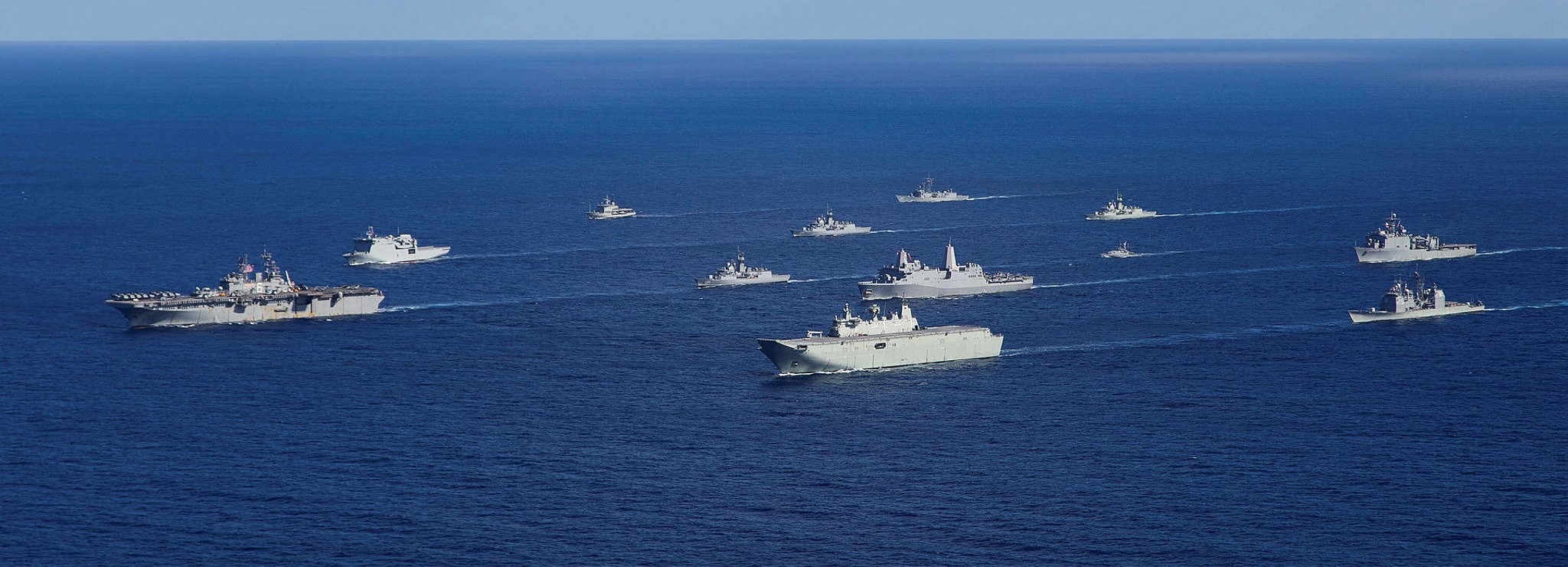
The Endurance 170 appears to be a very capable vessel, that will most definitely meet the requirements of the DCP 2019 as well is room for future-proofing any unseen requirements required by any Government. Very few countries can project power, but that number is growing and growing quickly.
- Ship to Shore : Amphibious Support Ships in The The Asia-Pacific Region
- How much for an enhanced sealift vessel?
- Other LHD operations
- Sense of scale
With the Draft of 6.6m, the LHD will be able to visit most of New Zealand's major ports, from Bluff, Port Chalmers Dunedin and 2 of the upper harbour berths, Timaru, Lyttleton, Nelson, Wellington, Napier, (possibly Gisborne), Tauranga, Auckland, Whangarei, New Plymouth and she can happily visit smaller communities and deep sheltered bays and use her landing craft as ferries for crew and visitors.
New Zealand has no offensive power and "The Five Powers Defence Arrangement" FPDA which we are a part of, they are noticing. The Future of the Five Power Defense Arrangements. The Endurance 170 will give New Zealand a form of offensive power by enabling the NZDF to have force projection. And if the vessel is armed properly even with what is suggested she will have have an offensive capability as well as power projection.
Let's just admit it China a growing regional power that is starting to push her way into our area's including the Pacific, and everyone is noticing this. China on the move...
One hopes for the best, but plans for the worst just like with the purchase of the P-8A Poseidens having the option to arm them to meet a threat but hopes they don't have to use this ability in anger, (Skyhawks anyone???) having the LHA/LHD, is in the same boat (excuse the pun) would be perfect for all the HADR but has the ability to project that military power if it had to or the need arises.
Overal having the Endurance 170 (or an evolved version of it) would be an excellent foreign policy choice.
So why would a "defence force" need power projection?
As a defence force, you need the ability to go on the offensive to defend our area of influence. The NZDF needs the ability to repel any aggressive manoeuvres and we don't really have this. Again as stated we don't have any offensive capabilities as such. So militarily wise, if we were attacked and the LHD/LHA survived the initial attacks say she was out on exercise somewhere, then she has the ability to project her forces to go on the offence to defend our country. To plan, organise and start any counter-attack if much of our infrastructure had been destroyed in initial attacks. (But let me point out the likelihood of this scenario actually happening, as in a direct attack is very low, but not impossible)
As already stated force projection does not always mean armed conflict. In a HADR situation having the major sealift and helo operations in a natural disaster-affected area is a huge asset for assistance and help with the path to recovery, as has been proved by HMNZS Canterbury on a number occasions.
Would not be seen as bludgers of the South Pacific.
The New Zealand government has seen how useful a military sealift ship can be, for both HADR and moving troops and equipment for both civil and military uses. They have known this since the first Fiji Coupe back in 1986 when they first discovered that we don't have that capability. They have had two attempts at it, with the first attempt an absolute disaster with HMNZS Charles Upham, and the second attempt HMNZS Canterbury having a rough start, and moderate success, but with limitations. Let's get it right this time.
A vessel with the capability of the Endurance 170 would greatly improve our status with our allies and we would not need to continuously "bludge" (I do hate this term but here we are) to get things transported, and while I do admit since has HMNZS Canterbury this has been less. I had this same argument with the possibility of the Royal New Zealand Air Force getting the C-17. Canterbury alone has enabled the NZDF to contribute a semi-sized force and equipment to exercises like "Talisman Sabre". So having the extra capability of a true LHA/LHD she would be the perfect upgrade to this.
She would be perfect as Command and flagship of the RNZN adding more to the scenario and response possibilities to the overall exercise or operation. With the help of HMNZS Aotearoa, she could stay on station for longer periods of time receiving fuel and dry goods and stores, including ammunition from the AOR, with this ability she would be a valuable asset that can help our allies and be an invaluable asset to the NZDF and NZG.
Morale
Having such a vessel would actually give a boost to the morale amongst armed forces, the sailors and airman that would serve on her and the soldiers that would disembark, knowing they finally have equipment that can meet a multitude of threats. Knowing they have a better chance of achieving the objective that was laid out too them. While morale not high on the list of reasons, (I originally was not even going to mention it) Having a vessel of this magnitude (whilst still being comparatively small) would make many of the troops proud. When the vessel is at berth, a sense of pride would be there. Even though they don't say it, you see it with the Australians and the Canberra Class LHD's, you see it their eyes, from the troops to the sailors and airman.
Having a vessel likes this would help with retention rates and recruitment. If I was younger and joining up I would be asking what branch do I need be to serve on her... that is where I want to be, and I am sure it would be for other young recruits as well.
- Defence Force morale at all-time low
- Troops slam senior leaders as Army ranks worst in Defence Force job survey
- How much for an enhanced sealift vessel?
- Change fatigue' in Defence Force
Pride and morale go a long way to having a good defence force. When New Zealand keeps making cut-backs and more cut-backs, and even more cut-backs it does lower morale, and when the New Zealand Government asked for even more cut-backs and the NZDF had to do the culling... it truly gutted the entire NZDF morale.
When equipment gets old and nearly unusable, it hurts morale, and when new equipment finally does comes online and it is not what you asked for and not up to the task... it hurts more than just morale. If we had the Endurance 170 in our fleet these vessels would become the pride of the Royal New Zealand Navy and over a short period of time the New Zealand people will have pride in these vessels even probably the "neigh sayers". Can you honestly say that about HMNZS Canterbury... no, and while we appreciate it and have great pride for the crew, not so much the actual ship itself it's a ferry and not really up to the full task she was asked to perform... sad but true.
Training
We would be able to cross-train with the Australians and USN on their LHD's and learn from their experience for the flight operations and many other operations of operating a Landing Helicopter Dock. As well as continue with Canterbury (until replaced) to fully enhance our amphibious operations. If the army so desired have a small marine corp battalion and that is what they specialise in.
Value for money
When you see Australia, who has had the capability to deploy and force projection, whilst it was limited in the past with ships like HMAS Tobruk (L50), HMAS Manoora (L 52) and HMAS Kanimbla (L 51) replace their ageing fleet with a modern LHD's and a LSL it tells you the benefit of having that capability out ways the cost.
This is one of the vessels in any navy that you if get built to a high standard, looked after properly and have system upgrades and maintained properly etc, could keep running for 40 years instead of the standard 25-30 years. HMS Queen Elizabeth is designed to last 50 years. Technically making it cheaper than a frigate.
Defence Capability Plan 2011
An exert from Defence Capability Plan 2011
In order to reach the goal of Total Defence Capability 2020, and thereby deliver the tasks outlined in the Defence White Paper 2010, the NZDF will focus on developing capability sets that combine a variety of military capabilities from across the three Services. These capability sets are grouped as:
- credible combat capabilities;
- deployable ground forces;
- strategic projection and logistics;
- command and control; and
- network-enabled intelligence, surveillance and reconnaissance.
The capability sets, which are not mutually exclusive, will comprise both existing and new or enhanced capabilities. Maintaining these capabilities will require ongoing investment in NZDF infrastructure, including information communications technology. Modern facilities that meet contemporary needs will provide quality support to NZDF operations. This Section outlines the main components of each capability set and illustrates how they relate to the Joint Amphibious Task Force and Total Defence Capability 2020 concepts. Further detail on the individual capability priorities within these capability sets is provided in Section 5.
On occasion, individual components of these capability sets will deploy on their own, such as the Special Operations Forces, which currently are in Afghanistan. But for the majority of situations, be it a combat or peacekeeping deployment, or a humanitarian assistance and disaster relief operation, the Joint Amphibious Task Force is a planning concept which enhances the utility of the individual NZDF elements it comprises. The emphasis within the Joint Amphibious Task Force is on a joint approach, integration, and having a wider understanding of the mission as a whole.
The importance of the combat capabilities of the NZDF, in the South Pacific and further afield, cannot be understated. It is these capabilities which underpin the overall utility, depth, and effectiveness of the NZDF, and thus its value to the Government and our partners. The NZDF must have the combination of personnel, equipment, training, and experience of working with other forces to allow the Government to make a credible, valued contribution when it needs or wishes to do so, including in higher intensity environments.
Well trained and operationally prepared ground forces, which includes Combat Units, Special Operations Forces, and Combat Support Units such as Engineers and Artillery, provide effective, credible, ground combat capabilities which the Government can deploy at short notice for a wide range of military tasks, including tasks alongside partner forces.
The ANZAC frigates and their integrated capability systems (guns, missiles, radars, sonar and electronic monitoring systems, and embarked helicopters) represent the only maritime force element capable of operating across the spectrum of operations from constabulary and humanitarian aid tasks to combat roles in a multi-national response to security events. The frigates also provide credible protection of forces afloat including amphibious sealift and logistical support platforms on passage and in location.
Helicopters provide a range of support, which includes tactical troop transport, command and control, search and rescue, and light utility roles. Planned integration with the naval platforms will enable support to amphibious tasks.
Embarked naval helicopters provide extended reach, surveillance, and air-delivered weapon capabilities (air-to-surface missile and anti-submarine torpedo) for the frigates.
Strategic projection and logistics
In our immediate region the ability to deploy forces across large maritime spaces, by both air and sea, into unstable, potentially hostile environments, and sustain them once there, is crucial to the conduct of NZDF tasks. The ability to respond quickly and effectively to humanitarian and disaster relief situations across our region is of particular importance.
Sealift for deployable forces is provided by the Multi-Role Vessel, HMNZS Canterbury, which is capable of embarking land forces and an air component, including helicopters and equipment. The ship can also provide a limited health support role through the embarkation of a surgical team. C-130 Hercules and B757 aircraft provide tactical and strategic airlift for personnel, equipment, and logistics, both inter- and intra-theatre.
replenishment capability may be enhanced to supplement and provide redundancy for HMNZS Canterbury, thus enabling an Amphibious Task Force to carry additional vehicles and equipment required by the ground force.
The naval combat force and other deployed NZDF assets are supported by a maritime projection and sustainment capability (currently the fleet replenishment ship, HMNZS Endeavour) enabling them to operate at greater distances than if they were operating independently. This capability carries supplies and fuel for the NZDF and its partners. It can re-supply ships at sea, or in overseas ports. The replenishment capability is a key regional enabler especially in projecting and sustaining an NZDF Joint Amphibious Task Force into the South Pacific. In the future this replenishment capability may be enhanced to supplement and provide redundancy for HMNZS Canterbury, thus enabling an Amphibious Task Force to carry additional vehicles and equipment required by the ground force.
Deployable ground forces require integrated capabilities that address land mobility, logistics, and medical support. These capabilities will meet the challenges of the contemporary operating environment and future operating concepts both at home and abroad.
Utility helicopters provide a range of logistic support, which includes troop transport and sustainment. Planned integration with the naval platforms will enable logistical support to amphibious tasks.
http://www.nzdf.mil.nz/downloads/pdf/general/defence%20capability%20plan.pdf
Where do I think HMNZS Canterbury lags?
HMNZS Canterbury was a cheap vessel, built to commercial standards, classed as a MRV or Multi-Role Vessel. The problem with any MRV is that they can do a variety of operations but only do them "okay"... but not do them all overly well, just passable. Designed to do too many things on a single platform.
The main problem is the lack of well-dock, Okay not the main problem,
The main problem is the lack of well-dock, Okay not the main problem, but for military use and even HADR the lack of a well-dock makes her limited to doing shore operations in calm sheltered bays. Having a well-dock would allow ship to shore operations conducted in a higher sea state. It was envisioned when she was built that she could do ship to shore operation up to sea state 3... then that was dropped to sea state 2 and then to a more realistic sea state 1. When I read this many years ago and saw she was not having a well dock, I remember saying there is no way they can do that with the paddle lock system to the LCM and rear ramp in sea state 3... a standard LPD or LHA with a well dock wouldn't want to be operating in much more than sea state 3 maybe 4... but that is rare.
A ship with a well dock (or docking well or well deck) can transfer cargo to landing craft in rougher seas than a ship that has to use cranes or a stern ramp. HMNZS Canterbury is classed as "Landing Platform, Amphibious" or LPA and basically performs the mission of amphibious transport, amphibious cargo ships, and amphibious dock landing ships. She carries landing craft on the upper deck and can load cargo from a stern door, the stern is superficially similar in appearance to that of the LSD and LPD, but the deck does not flood. She can also load cargo to her LCM's via the 60-ton cranes that are used to lower the LCM's. The effectiveness of either method is heavily dependent on favourable conditions and are generally not feasible above Sea State 1 or 2.
It showed how naive the MoD and the government were at the time to think that they could get that to work in that sea state. The navy was saying at the time that is would not work, but typical Government, it fell on deaf ears. There were other concerns that were raised during construction but again fell on deaf ears and the If you don't listen to the personnel that operate the equipment and that will operate the new equipment when they say it shouldn't be done this way... Then you should listen.
HMNZS Canterbury could have had a well-dock, when she was built, however, two things would have happened;
- The cost of the vessel would have been much more than the 130-150 million NZ Dollars.
- She would not be able to carry as many vehicles and equipment, due to the space the well dock takes up.
- To counter this shortfall you could make the vessel longer, but this brings us back to point 1, cost.

HMNZS Canterbury and one of her LCM's
Canterbury, as everyone knows, was based on a commercial ferry and usually filled with vehicles but being a military vessel she would not always sail with a full load, this cause issues and considered less seaworthy than specified. She has had major work done to remedy these issues. In September 2008, an independent review of the safety and functionality of the ship revealed that some operating limitations will have to be accepted, as sea-keeping performance is poor in high sea states. The "selection of a commercial Roll-on, Roll-off (Ro-Ro) design" has "been at the root of differences of opinion between Tenix, the Ministry of Defence and New Zealand Defence Force and the shortfalls in performance". The issues included that the propellers can come out of the water when the ship pitches in rough seas, with concern that this may affect the ship's machinery. The report also recommended relocating the ship's boats (or protecting them from waves if relocation was not possible) and adding more ballast or improving the ballasting system of Canterbury. These upgrades have now been completed. The RHIB alcoves are now further forward and higher, and more ballast has been added to help with sea keeping. This was all completed before the Pacific Partnership 2013 Exercise.
With these alterations, Canterbury can now only carry x3 NH-90 and x1 Sea Sprite, where she was supposed to carry x4 NH-90 and x1 SeaSprites (or a mix thereof). Apparently, while she is capable of operating two Sea Sprites at once with her current radar and command systems this no the best or easiest and now basically is limited to operating one at a time. (I do believe that her radar, communications and command systems are getting an upgrade, but not sure when.)
as with all NZ vessels, Canterbury is under-armed for a naval vessel.
She is too short and fat and because she is also designed to go south, instead of having the standard stabilisers she uses ballast tanks, which really only work when the vessel is loaded. Overall she was too small to meet our requirements and tried to do too many things. From a training ship (which she is good at) to sealift with a limited ship to shore, patrol vessel which she has never really done, she has never needed her ice belt. Her medical ward is too small, and her command systems and radar need a major overhaul and are pretty limited. And as with all NZ vessels, Canterbury is under-armed for a naval vessel.
So we now have a vessel that can carry equipment and in a limited capacity do ship to shore in the right sea state. She can rarely sail anywhere when she is lightly laden, and operating dual helos now very limited, reduced to only carrying 3 NH-90 instead of the original 4. Her self defence weapons are not really self-defence unless you are trying to attack a rowboat...
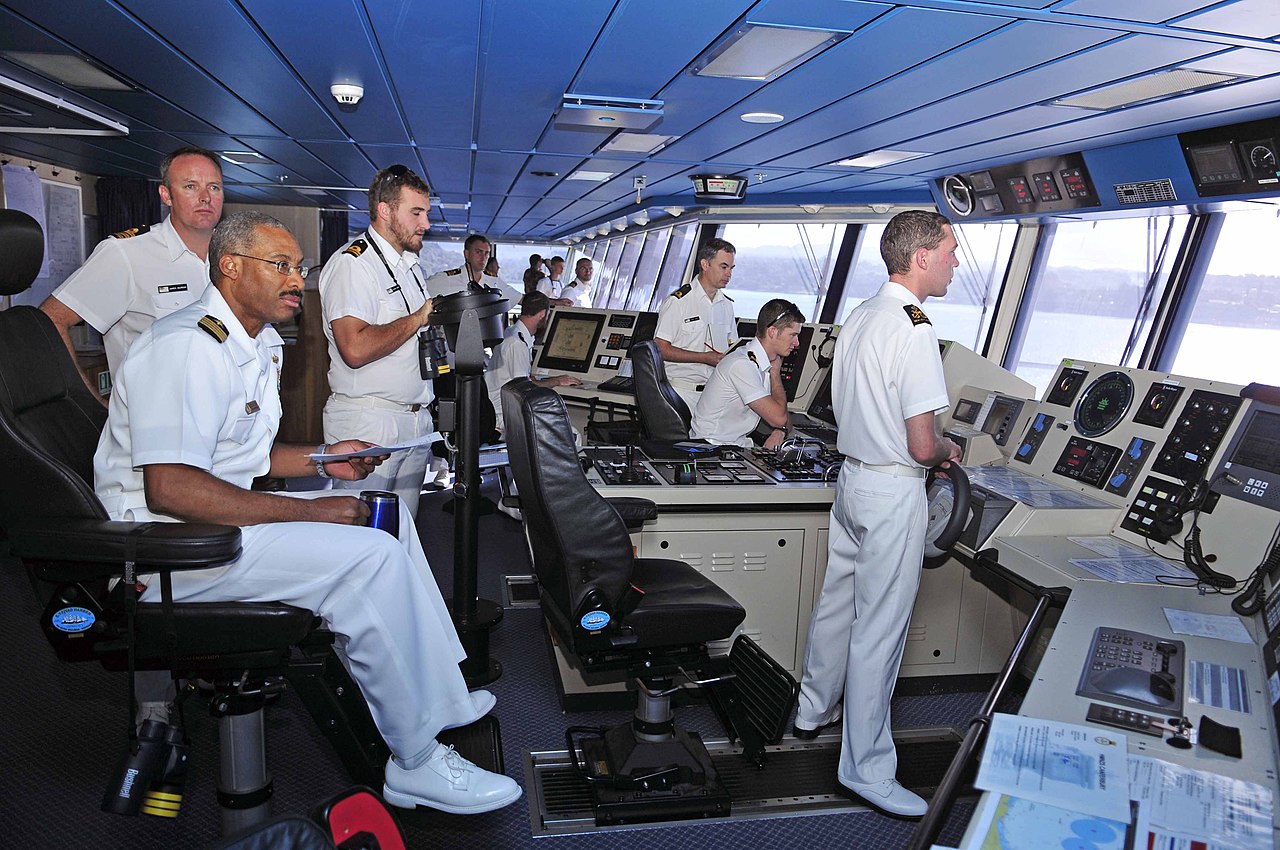
PORT VILA, Vanuatu (April 23, 2011) Capt. Jesse A. Wilson commander of Pacific Partnership and commodore of Destroyer Squadron 23 (DESRON 23), sits in the captain's chair aboard the New Zealand navy multi-role vessel HMNZS Canterbury (L421) during a sea and anchor detail in Port Vila, Vanuatu. Pacific Partnership is a humanitarian assistance initiative which promotes cooperation throughout the Pacific
But... on saying all that, HMNZS Canterbury has prooven herself during Christchurch and Kaikoura Earth Quakes, and various other HADR operations in the pacific region and she does this well. She has been a good stepping stone in learning amphibious operations for the NZ Army and RNZN, and the RNZN has learnt what the can and can not do with her. She will still be a great training ship, and great for HADR but to be completely honest that's about it.
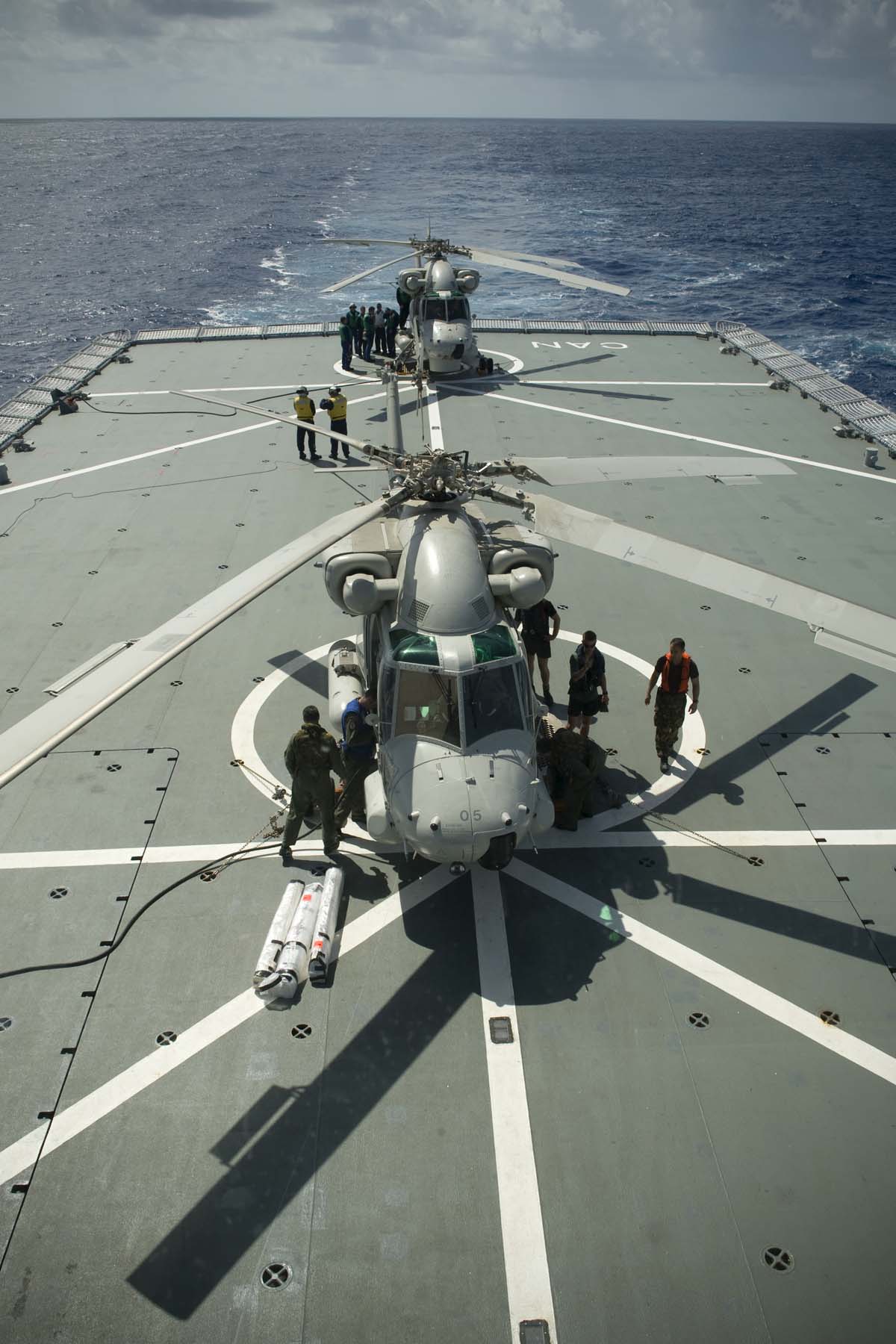
2 Sea Sprites on Canterbury's flight deck
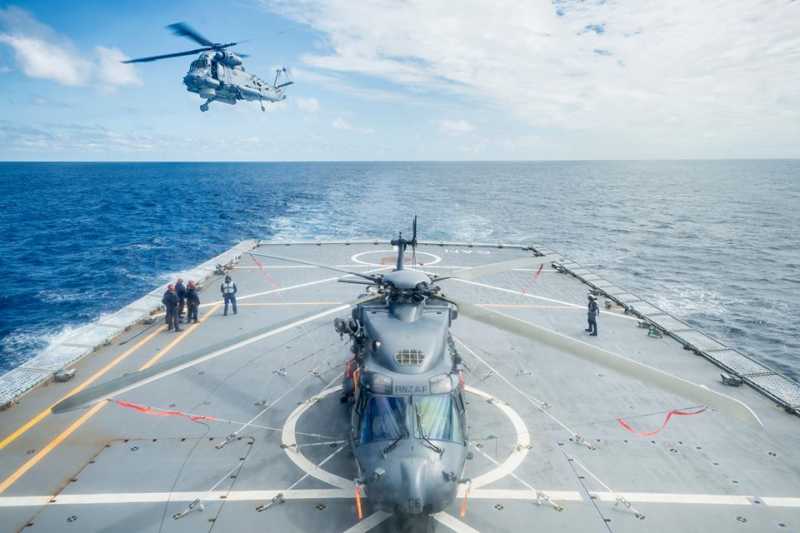
Sea Sprite launches from the aft pad of Canterbury with and NH-90 on the fwd pad.
https://twitter.com/NZDefenceForce/status/996263925967503360
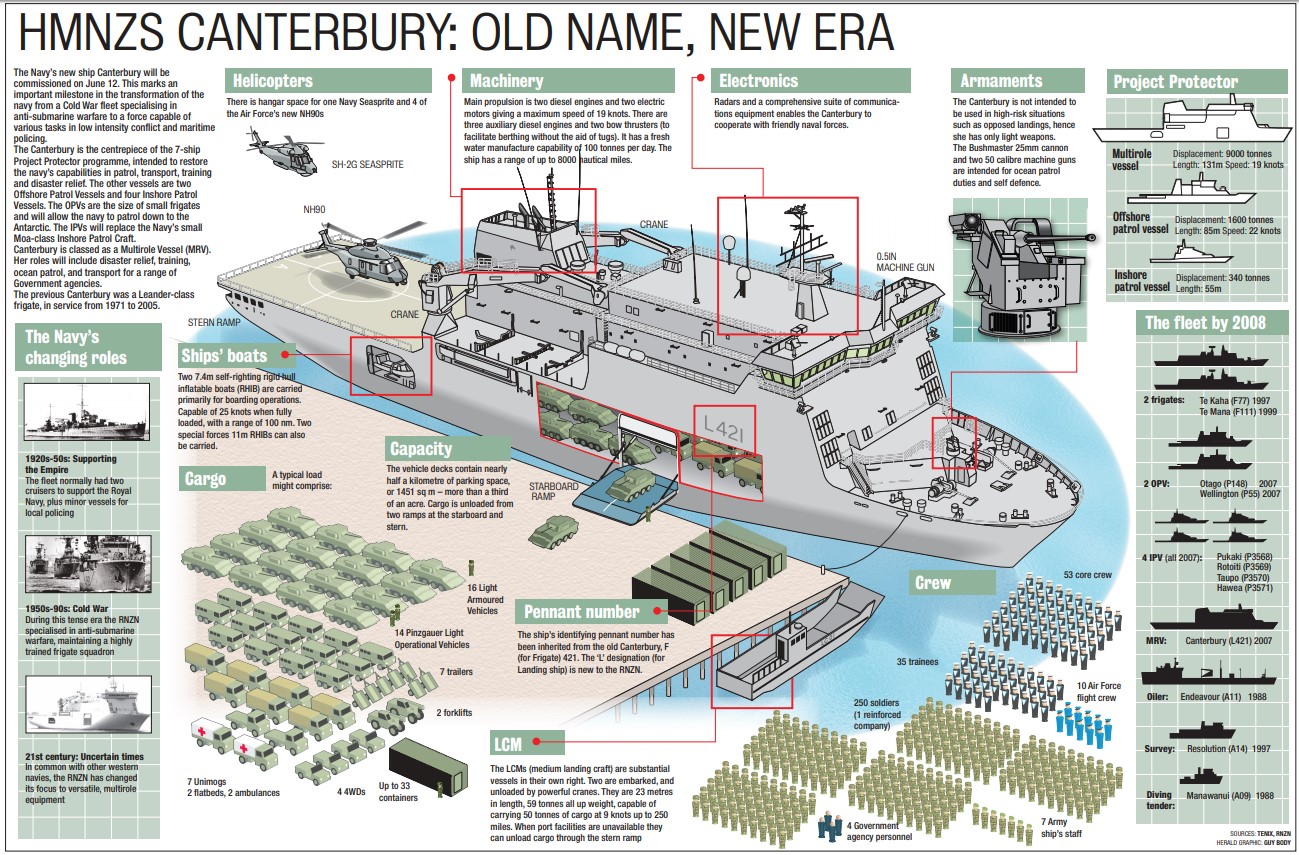
One of the original diagrams show the capabilities of HMNZS Canterbury. Remembering now after the alterations, the reduced number of NH-90s, and 1 SeaSprite.
- Canterbury tales retold RNZN multirole vessel delivers
- The Tulagi turning point
- How much for an enhanced sealift vessel?
- The Future of the Five Power Defense Arrangements
It is time for the NZG and people to step-up on defence. Get your heads out of the sand, look at what is happening in the world and look at what is slowly creeping into our region areas of interests. We need to start getting the proper equipment, stop taking short cuts... which will eventually get people killed because it is not the right equipment to do the job they were asked to do. While Canterbury has been a good stepping stone to learn amphibious operations, the limitations are now starting to show that she not fully meeting the requirements
Are there any downsides to having the Endurance 170?
Simply put not really, there is no real reason why a vessel of the Endurance 170 class could not be in the Royal New Zealand Navy service, (if not 2) the vessels will be able to meet any requirements the New Zealand Government throws at it, from HADR to Armed Force Projection and will be great for just showing the flag around the world. The perfect flagship of the navy and it will show everyone that we do take the security of our region seriously.
- 4 Frigate Navy
- How much for an enhanced sealift vessel?
- Options for the NZDF and RNZN 2nd enhanced Sealift vessel
However, from this, we need to go back to a four frigate navy as a vessel like this needs an escort, and would very rarely sail on her own.
| Edit: As has been pointed out to me, this is not strictly true, and I actually agree, she can happily sail on her own during HADR operations, or even to joint various exercises, and in benign area's etc... but to the average layman all they think is it is a warship and all it does is to go fight battles... (sad but mostly true) or they are always in a hot zone and as I have pointed out, no... that's not true either. The good thing is this attitude is slowly changing. I should have worded that better and say along the lines of, if she was to ever to go into a hot zone for patrols and operations, she would have an escort. Whether the escort vessels is an ally or one of our own frigates escorting her. Many people have seen the good the navy have done, even what a warship can do and offer in the time of need, the Kaikoura earthquake is the perfect example of this. I remember when it happened and someone I know (admittedly she lived in Kaikoura so was a bit rattled by it all) She complained, "would it no be better to send trucks and bulldozers and not WAR Ships." I had to point out to her the aid that these ships can bring, pointing out the helo's alone will move aid to areas that are no longer accessible by road, the ships can make freshwater, food, medical care, they can supply boots on the ground for the initial clean up, they give moral support in the time of need to let you know you are not alone. I then had to point out that HMNZS Canterbury will be loaded up with aid, that she isn't the warship you think she is, and she can bring all that aid ashore and she can evacuate personal if needed... which she ended up doing. |
Another issue is manning with a crew of 300, 150 core crew and 150 flight crew, (and if we have two then that is 600 personal.) That is starting to stretch the manning resources of the current personal. So now is the time to start to get the personal and training them for this type of vessel and increase the size of our navy, we are an island nation surrounded by the ocean after all.
With this type of vessel in the fleet, it would actually make it easier to recruit the younger generation as there is more likely the chance that they want to serve on it... I mean who wouldn't... it will be the first time New Zealand would have owned and operated a flat top type vessel, and having all the flight operations makes it exciting to see... heck I would rejoin if I could to serve on her. So the younger generation sees it, and say I want to do that...
The other issue is a shortage of helo's (which I am bluntly going to say) we have always had a shortage of and it makes it difficult to just meet some of the basic requirements of the Government.
So we would need more sub-hunting Helos more than the current eight. We will need more medium-sized helos either more NH-90 or another that are fully marinized to be able to handle the harsh environment of the sea and saltwater etc.. And here is the kicker, personally some form of attack helo's for doing the recon, and force projection work and some air cover for the ground troops.
The Endurance 170 vessel can carry 10 medium-sized helicopters, so 5 NH-90 to do the force projection, 3 attack helo of some kind, and 2 ASW to help with fleet protection, S&R and general duties etc.
So the downside which would the hard sell is basically to use the vessel to its full capacity it needs a bit more money. We could operate one vessel with what we have, but it would leave short for the other ships in the navy, and we still would have no air cover.

